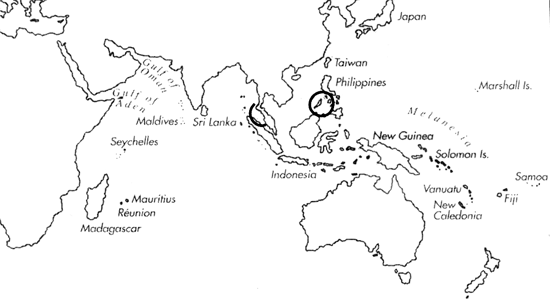Range: Philippines (Palawan, Sulu Sea) and W. Thailand.
Description: Moderately small to medium-sized, moderately solid. Last whorl ventricosely conical; outline convex adapically, less so or straight below; left side sigmoid. Shoulder subangulate. Spire of moderate height, outline slightly concave or slightly sigmoid. Early postnuclear whorls tuberculate. Teleoconch sutural ramps nearly flat, with 2 increasing to 4 spiral grooves; additional spiral striae on latest ramps. Last whorl with spiral ribs toward base.
| Shell Morphometry | ||
|---|---|---|
| L | 30-49 mm | |
| RW | 0.10-0.22 g/mm | |
| RD | 0.54-0.62 | |
| PMD | 0.77-0.85 | |
| RSH | 0.11-0.17 | |
Ground colour white. Last whorl with medium-sized to large, orange to brown axial blotches, usually connected to an irregular meshwork that often outlines triangular white areas or tents. Shells with reduced reticular pattern intergrade with shells having last whorl overlaid with brown except for white blotches at centre and below shoulder. Dotted to solid orange to brown spiral lines extend from base to shoulder but are often reduced. Postnuclear sutural ramps with radial blotches of orange to dark brown. Aperture white.
Habitat and Habits: Reported from about 30 m; living on coral rubble and patches of sand.
Discussion: C. fischoederi is similar in shape to C. achatinus, C. monachus, C. striolatus and C. catus but differs so clearly from all these species in its colour pattern as to exclude any confusion. For comparison of C. fischoederi with C. magus and C. spectrum see the DISCUSSION of these species.

C. fischoederi range map
This section contains verbatim reproductions of the accounts of 316 species of Conus from the Indo-Pacific region, from Manual of the Living Conidae, by Röckel, Korn and Kohn (1995). They are reproduced with the kind permission of the present publisher, Conchbooks.
All plates and figures referred to in the text are also in Röckel, Korn & Kohn, 1995. Manual of the Living Conidae Vol. 1: Indo-Pacific Region.
The range maps have been modified so that each species account has it own map, rather than one map that showed the ranges of several species in the original work. This was necessary because each species account is on a separate page on the website and not confined to the order of accounts in the book.